FTL Technology
More actions
Faster-than-light travel refers to a range of technologies and, in some cases, natural phenomena that enable a starship to exceed the speed of light by surpassing the warp threshold, achieving velocities otherwise considered unattainable. These technologies rely on access to subspace, as there are otherwise no known natural methods to move faster than the speed of light.
Warp Drive

The standard method of faster-than-light travel for nearly all known powers in the Milky Way, including the United Federation of Planets exploratory arm, Starfleet, warp drive is a method of bending subspace to move objects faster than would be possible under relativistic physics. The power demands required to take a ship to warp are extremely large, and so the majority of spacefaring races use controlled anti-matter/matter reactions to generate sufficient energy, but other methods including forced singularity cores and exotic particle reactors are also used.
Transwarp
Transwarp is a method of propulsion through subspace that exceeds the traditional limits of warp speed by accessing a realm of subspace known as transwarp space. Transwarp technology is only known to be deployed successfully and consistently by a handful of species such as the Borg Collective and Voth. In the example of the Borg, their ships utilize transwarp coils to power directly from the ship's power core into a deflector which opens a transwarp conduit, allowing the ship to enter transwarp. When a vessel enters a conduit, it encounters intense gravimetric shear. To counteract this, the Borg employs a structural integrity field projected in front of the ship. Furthermore, a vessel endures significant temporal stresses, requiring the projection of a chroniton field throughout the ship to maintain temporal synchronization between its various sections.
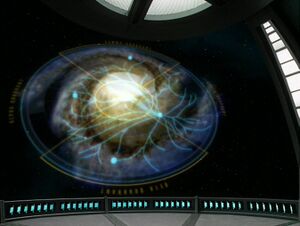
In addition to the ship-based transwarp, the Borg also maintains a vast network across the entire Milky Way Galaxy of transwarp corridors created by five transwarp hubs. While there were originally six, it is unknown to the Federation if the one destroyed by the USS Voyager on its return trip home has been rebuilt. The transwarp corridors created by these hubs and maintained by the Borg have been known to shift and fall into disrepair or disuse over time. While not maintained at peak efficiency, the transwarp corridors remain and ships have been known to be able to use them to quickly move from one fixed point to another.
The Federation has conceptualized a Federation transwarp network using the abandoned Borg corridors. However, the threat of interfering with even abandoned Borg technology is perilous. When the Borg reverted to their natural state with the termination of the Queen Protocol in 2401, it seemed more dangerous than ever to provoke the Borg and the Federation has only kept these concepts in the research stage.
As of 2402, the main method for Starfleet vessels to use transwarp technology is by either acquiring a salvaged Borg transwarp coil, and risk provoking the Borg who often return to salvage their technology. Or by knowing the precise location of a transwarp conduit, of which Starfleet only has a vague understanding of the overall network.
Quantum Slipstream Drive
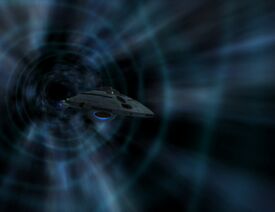
Quantum Slipstream Drive (QSD) works by having a starship's main deflector generate a quantum field to penetrate the quantum barrier underpinning space-time, allowing for maintained speeds far in excess of modern warp drives. QSD does not require antimatter to function, though the system does require high energy outputs to initiate and operate, for which modern matter/antimatter reactors are especially apt. A major component of Federation QSDs is benamite crystals, used as a focusing component for the quantum field. These rare crystals are the current primary limitation on the use and deployment of Quantum Slipstream Drives in the modern Starfleet, restricting the system to a handful of closely guarded ships at most currently. The technology was first encountered by USS Voyager in the Delta Quadrant, originally developed by a species the Borg designated as Species 116.
As of 2402, the main hindrance to Starfleet utilization is the extreme rarity of benamite crystals and the inability to synthesize them artificially. If benamite is available, the components needed to retrofit a warp core as a quantum slipstream drive are straight forward and the parts can be replicated on most starships.
Soliton Wave
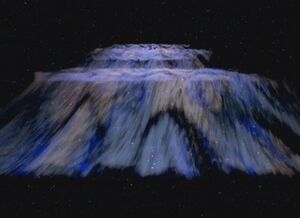
Soliton waves are an alternative faster-than-light technology compared to the more typical implementations. Soliton waves are generated by a distribution of field coils that generate enough directed energy to produce a soliton wave. The soliton wave is then directed towards a waiting vessel, which the wave pushes into subspace. The receiving facility waits for the vessel to arrive and projects a counteracting scattering field which dissipates the soliton wave, allowing the vessel to arrive safely.
Soliton wave travel was, at one point, theorized to be much more efficient and less damaging to subspace. However, during test trials in 2368, it was discovered that soliton waves unexpectedly built up energy while interacting with subspace. This made the waves incredibly powerful and dangerous to anything in their path. Because of this, the technology was put on hold pending further research.
As of 2402, the technology is readily available to Starfleet and the fundamental understanding is sound if the technology ever needed to be deployed.
Spatial Trajector
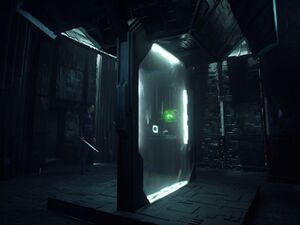
The Federation first encountered the spatial trajectory technology in 2371 when the crew of the USS Voyager made first contact with the Sikarians. The technology allowed the Sikarians to transport individuals over 40,000 light years in an instant by simply stepping on a platform.
The trajector functioned by folding space, using antineutrinos as a catalyst for the process. It enveloped the object or person being transported in a neutrino field. At the time, the technology entirely relied on Sikaris' mantle of tetrahedral quartz to focus and enhance the trajector's power. This reliance restricted the device's operation to the planet or its immediate vicinity. However, by 2380, the Borg had assimilated Sikarians and adapted the technology to work in any location. Most notably, each queencell in a Borg cube was equipped with one so that the Queen could escape in an emergency.
At this point in time, the Federation possesses the technology as scans of the trajectory matrix were brought home by Voyager. However, Starfleet has been unable to overcome the original restrictions of requiring the Sikaris' mantle.
Graviton Catapult
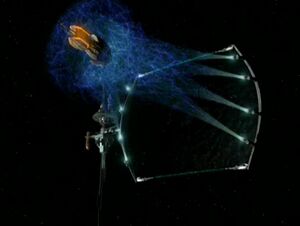
The graviton catapult is another technology encountered by the USS Voyager, in 2376. The catapult functions by its power core unleashing a powerful graviton surge, channeled through a network of projectors to lock onto a ship. This surge propels the vessel into null space for several hours. When the ship reemerges in normal space, it has traveled hundreds or even thousands of light-years, with the distance determined by the strength of the graviton field.
This technology is well known to the Federation, however, it is resource intensive with catapults needing to be built extensively and far-spread to make it a feasible alternative to warp drive.
Underspace
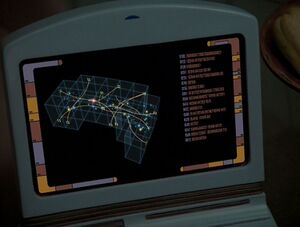
The Underspace is a network of subspace corridors extending through large reaches of the Delta Quadrant, allowing swift travel across vast distances. Its use is largely controlled by the Turei Alliance, who have granted Starfleet limited access.
The first known users of the Underspace were the Vaadwaur prior to the 15th century. With a reach as far as Talaxian territory, they used the Underspace for trade, exploration, raiding, and expansion, but kept no written records of the phenomenon. When the Vaadwaur were defeated by the Turei and their allies, this understanding and knowledge were lost.
As of 2402, Starfleet has a crude understanding of Underspace and partial maps throughout the Delta Quadrant and some beyond. However, the knowledge is sufficient to use the corridors more or less safely if encountered.
In Play
- Most of the alternative FTL technologies to warp travel are not used by Starfleet for various reasons, including access to resources (Quantum Slipstream Drive), danger (transwarp), lack of understanding (Underspace), or simple inefficiency compared to warp drive (graviton catapults). They may be available and possible, depending on a story's needs, but should be used only as the narrative requires.
- The Bravo Fleet Intelligence Office is disinterested in making, for example, QSD available as a matter of course. We feel our setting is more interesting if space is allowed to be 'big,' if traversing the galaxy can take time. Under some circumstances, accessing a setting is more important, and members are of course welcome to portray parts of Trek canon distant from the Federation, such as Ocampa. Means of accessing those areas exist, such as Underspace, but come with IC restrictions and challenges that make these journeys possible, but not easy.
- During the 2025 Fleet Action Nightfall, ships of the Fourth Fleet may draw on the technologies listed here to overcome the warp-cancelling effects of the Blackout phenomenon and take the fight to the Vaadwaur Supremacy. Some of these technologies are a 'break glass in case of emergency' use - this is the time to break glass. It goes without saying that the use of these technologies will be limited to the emergency of the FA storyline, rather than, again, the example of QSD becoming widely available.
